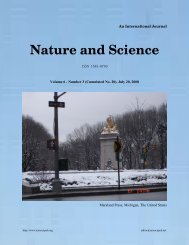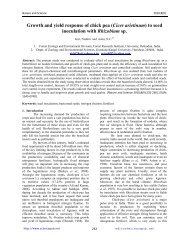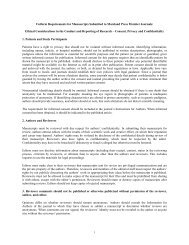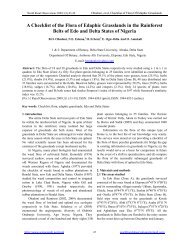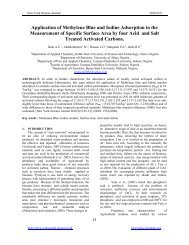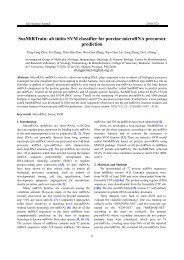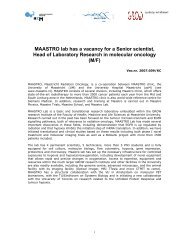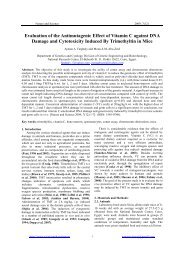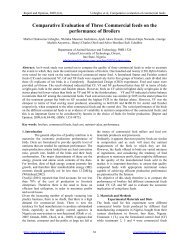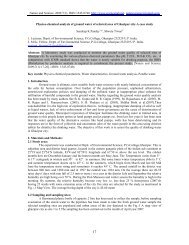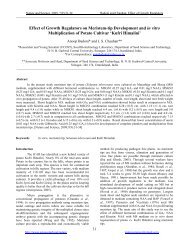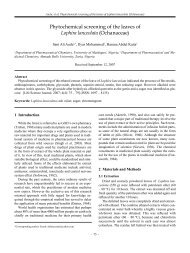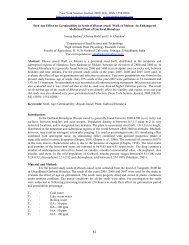Ecological, Social and Commercial Role of Lichens in India with ...
Ecological, Social and Commercial Role of Lichens in India with ...
Ecological, Social and Commercial Role of Lichens in India with ...
Create successful ePaper yourself
Turn your PDF publications into a flip-book with our unique Google optimized e-Paper software.
[[<br />
Acdemia Arena 2010, Supplement 0201<br />
http://www.sciencepub.net<br />
Chapter-7<br />
SEASONAL PATTERN OF LICHEN FALL FROM TREES IN AN EVERGREEN<br />
QUERCUS SEMECARPIFOLIA FOREST OF GARHWAL HIMALAYA, INDIA<br />
(BALWANT KUMAR*, DILIP K. UPRETI**, S. P. SINGH***, ASHISH TIWARI****)<br />
*Department <strong>of</strong> Botany, D. S. B. Campus Kumaun University, Na<strong>in</strong>ital (Uttarakh<strong>and</strong>) 263001.<br />
**National Botanical Research Institute, Lucknow (Uttar Pradesh) - <strong>India</strong>.<br />
***Advisor, Sri Guru Ram Rai Education Mission, Institute <strong>of</strong> Technology & Science, Patel Nagar,<br />
Dehradun (<strong>India</strong>)<br />
****Department <strong>of</strong> Forestry, D. S. B. Campus Kumaun University, Na<strong>in</strong>ital (Uttarakh<strong>and</strong>) 263001.<br />
ABSTRACT<br />
The Himalaya is one <strong>of</strong> the richest sources <strong>with</strong> respect to the occurrence <strong>of</strong> lichen on oak species.<br />
These unique symbiotic organisms that contribute to biodiversity <strong>and</strong> are important as food <strong>and</strong><br />
shelter for various wild animals are be<strong>in</strong>g lost because <strong>of</strong> unsystematic harvest<strong>in</strong>g. We purpose that<br />
collection <strong>of</strong> fallen lichens would reduce lichen diversity loss. In the paper we have documented the<br />
seasonal pattern <strong>of</strong> lichen <strong>and</strong> twig fall, <strong>and</strong> frequency <strong>of</strong> fall <strong>of</strong> common genera <strong>in</strong> closed <strong>and</strong> open<br />
canopied forests <strong>of</strong> Quercus semecarpifolia (the brown oak) <strong>in</strong> a moist temperate forest <strong>of</strong> Garhwal<br />
Himalaya. The annual fall <strong>of</strong> marketable material was 6.4 kg/ha/yr <strong>in</strong> the open canopied forest. The<br />
lichen fall was maximum <strong>in</strong> the early summer seasons (April-May) at both sites. Lichen collection<br />
from the oak forests (Quercus species) is carried out <strong>with</strong>out any consideration for susta<strong>in</strong>ability.<br />
The branches are chopped <strong>and</strong> the bark scraped <strong>of</strong>f us<strong>in</strong>g sickles <strong>and</strong> axes.<br />
Key Words: Lichen fall, Quercus semecarpifolia, Garhwal Himalaya.<br />
INTRODUCTION<br />
Accord<strong>in</strong>g to the concept <strong>of</strong> basic adaptational strategy <strong>of</strong> plants (Grime 1977), lichens are<br />
stress-tolerant organisms. Such organisms are not expected to survive deficiency <strong>in</strong> resources<br />
(stress), as well as destruction <strong>of</strong> biomass (disturbance). In Uttarakh<strong>and</strong> <strong>and</strong> much <strong>of</strong> the other<br />
Himalayan regions people harvest lichens from forests, particularly from oak (Quercus) trees<br />
70



